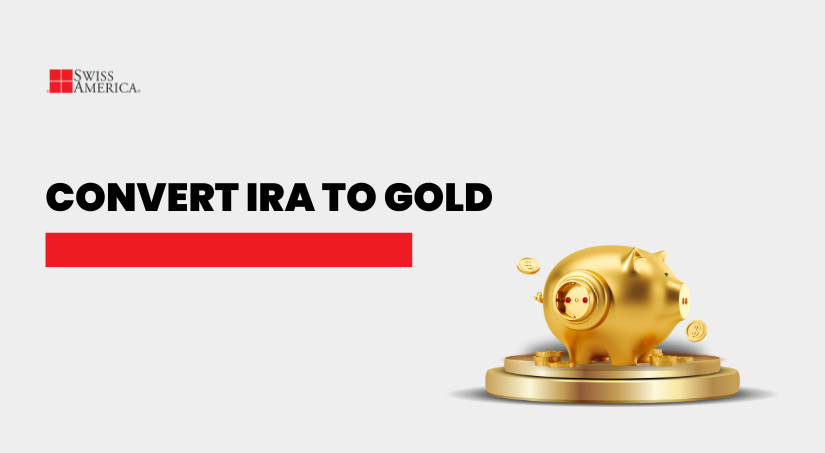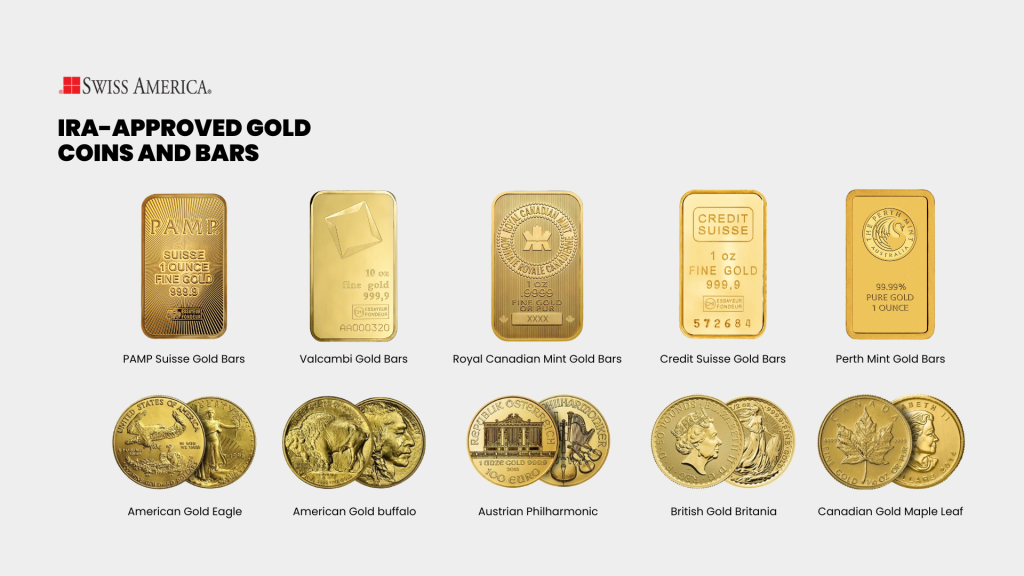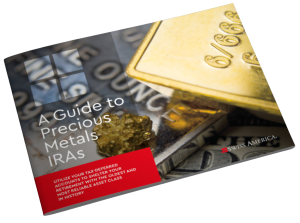
Economic volatility and high inflation are eroding purchasing power. Consumer price inflation has stood at 3% over the last year, while personal income growth is around 1.9% straining Americans’ finances. This environment calls for protective investment strategies in inflation-defensive assets like gold.
If you have retirement savings, you can convert IRA to gold. This is such a popular investment strategy that 21% of Swiss America customers bought precious metals with Gold IRAs in 2025.
It’s not difficult to make this change at all. You can convert your existing IRA into a Gold IRA in a few quick steps. It’s also possible to fund your new IRA with other retirement accounts, such as Roth IRAs, 401(k)’s, and more.
Here, we cover the conversion process and how it works.
What is a Gold IRA?
When planning your retirement, your goal is simple: protect and grow your wealth as best you can. A Gold IRA is one of the best ways to accomplish both goals. This type of IRA allows you to diversify your portfolio by including physical assets like gold, silver, or platinum.
With a Gold IRA, you own physical gold with all the tax benefits of an IRA. This makes these retirement accounts a great option for those looking to hedge against economic uncertainty and inflation.
Gold IRA vs a traditional IRA
Both Gold IRAs and traditional IRAs will help you save for retirement, but there are several differences between the two:
Investment options: Traditional IRAs primarily invest in stocks, bonds, and mutual funds, while Gold IRAs allow you to hold physical gold and other precious metals.
Custodian requirements: Gold IRAs require a specialized Gold IRA custodian to manage the physical assets, whereas traditional IRAs can be managed by traditional stock market-related financial institutions.
Tax advantages: Gold IRAs and traditional IRAs offer tax-deferred growth, but the specifics of taxation can vary based on the type of IRA (traditional vs. Roth) and the timing of contributions and withdrawals.
Market exposure: Traditional IRAs are more exposed to stock market volatility, while Gold IRAs provide a buffer through tangible assets like gold, which historically hold value in uncertain economic times.
Here’s a quick summary of the main differences:
| Category | Gold IRA | Traditional IRA |
|---|---|---|
| Investment options | Holds physical gold and other precious metals | Invests in stocks, bonds, mutual funds |
| Custodian requirements | Needs a specialized Gold IRA custodian for physical assets | Managed by standard financial institutions |
| Tax advantages | Tax-deferred growth. Rules depend on IRA type and timing of contributions and withdrawals | Tax-deferred growth. Rules depend on IRA type and timing of contributions and withdrawals |
| Market exposure | Provides a buffer through tangible assets that can hold value in uncertain economies | More exposed to stock market volatility |
Why convert IRA to gold?
The reason people look at Gold IRAs is to have an asset that acts as a hedge against market volatility and inflation. But how does this work, and why might it suit your financial strategy?
Hedge against market volatility
Markets can be unpredictable. Stock prices fluctuate, economic conditions shift, and geopolitical events can upend your investments. These are the times when gold really shines, so to speak.
Known as a “safe-haven asset,” gold tends to retain or even increase its value during economic downturns, providing a layer of security that traditional assets might lack.
Inflation protection
As you’ve seen, inflation silently erodes wealth. As the cost of goods and services rises, your money’s purchasing power diminishes. Gold has a long history of being an effective inflation hedge. Since the year 2000, gold prices have risen by over 1,352%.
Portfolio diversification
Relying solely on traditional financial assets like stocks and bonds can expose your portfolio to significant risk. If you diversify your investments to include a Gold IRA, you can spread risk across different asset classes.
This diversification can help smooth out market volatility, reducing your overall risk exposure, and it’s why many experts recommend holding 5%-15% of your portfolio in gold.
Wealth preservation
Economic uncertainty is inevitable, whether because of financial crises, political instability, or global events. Gold’s intrinsic value and historical performance during these times make it a good choice to preserve wealth.
When stock markets waver and currencies fluctuate, gold’s resilience provides a sense of security.
Is a Gold IRA right for you?
Before you head down the path of setting up a Gold IRA, here’s a few considerations to see if it’s the right fit for you:
Investment goals
Gold offers a way to balance traditional investments like stocks and bonds by adding a tangible asset to your savings. However, gold doesn’t generate income like stocks or bonds.
It’s primarily a defensive asset designed to preserve wealth rather than provide growth. This is why you should view gold as part of a diversified portfolio rather than a standalone solution.
Long-term strategy
Gold IRAs are a great option for long-term investing, but if you are only looking for a short-term asset, this type of account might not be the best approach for your scenario. All investments have risks, and gold isn’t any different.
Gold prices can change based on factors such as global economic conditions, supply and demand dynamics, and geopolitical events. These ups and downs may impact the value of your retirement savings in the short term.
Be aware of what’s happening in the market and take a long-term view.
Fee considerations
Besides the gold IRA custodian fees, you’ll also pay gold dealer premiums over the spot price of gold or other precious metals. Consider these costs when you look at your overall potential returns.
IRS regulations
You won’t be able to keep your gold at home, you can’t buy collectibles, and you need to follow the withdrawal rules and timelines to avoid tax penalties.
How to open a self-directed Gold IRA account
Opening a self-directed Gold IRA account is simpler than you might think.
Here are the steps:
Step 1: Eligibility for a Gold IRA
Most of the time, you can convert your existing traditional, Roth, Simple, or SEP IRA to a Gold IRA without any issues.
If you’re looking to add physical gold bullion to diversify your portfolio, you can also convert just a portion of your IRA to whatever allocation you and/or your financial advisor decide.
Step 2: Choose a Gold IRA custodian
Traditional stock-market-focused institutions rarely offer Gold IRAs, so you need a precious metals specialist and custodian who handles self-directed IRAs.
The custodian’s role is to buy and sell gold on your behalf, securely store your gold, and handle ongoing administrative reporting. Fees and costs vary by custodian, but generally, you’ll have:
| Fee Type | Typical Range | Details |
|---|---|---|
| One time setup fee | $50 to $100 | You pay this when you open the account |
| Annual management fee | $90 to $300 per year | Covers admin work and IRS reporting each year |
| Commingled storage | Ranges from flat fee to a percentage of your holdings | Shared vault space at the depository |
| Insurance | Usually included in storage | One-time setup fee |
It pays to compare options to find the right Gold IRA company. Besides fees, you should also check out the custodian’s reputation and reviews, and find out if there are minimum investment requirements.
Once you’ve decided on a custodian, open a self-directed Gold IRA account by filling out the forms and providing identification.
Step 3: Funding your Gold IRA account
Once you have your self-directed Gold IRA, you can add money to it. You can do this by transferring a portion of funds from your existing traditional IRA. You have two options:
- Direct rollover: With this trustee-to-trustee transaction, you’ll ask your current IRA administrator to send the funds directly to your new SDIRA account. This is the easiest and best method to avoid potential taxes and penalties.
- Indirect rollover: You can also withdraw the funds and then deposit them into your Gold IRA account within 60 days. If you choose this 60-day rollover method, make sure you can meet the deadlines, or you’ll have taxes like a 10% early withdrawal penalty.
If you have retirement savings with an employer and have left that employer, you can also roll over funds from your 401(k), 403(b), or TSP account.
You can also use a direct or indirect rollover for these accounts. Direct is best for fewer IRS rules and potential tax penalties if you miss deadlines.
Step 4: Choose gold investments
The IRS has specific rules regarding which metals you can buy with retirement savings. The goal is to protect you from low-quality investments, counterfeit gold, or other scams. The gold bars or coins you buy must be 99.5% pure and come from an approved manufacturer or mint.
A gold dealer like Swiss America can help guide you through various options, like some of the coins and bars below:

Step 5: Gold storage
Once you buy your metals, your custodian places them in an IRS-approved depository. You can’t store your gold at home because the IRS considers this a withdrawal of your retirement savings.
Depositories offer the option of either commingled or segregated storage. With commingled, your gold bullion bars and coins get stored and tracked as part of a larger pool of metals. In a segregated depository, the depository keeps your metals separate from those of other investors.
Step 6: Monitor and rebalance as needed
Gold is very easy to own, and you don’t need to check its value every day, but it’s a good idea to monitor your account and rebalance your holdings if needed. Regularly reviewing and adjusting your Gold IRA helps keep your investments aligned with your financial goals and adapt to changing market conditions.
Maintenance tips for your Gold IRA
Owning a Gold IRA requires ongoing attention to ensure it aligns with your financial goals. Regularly review your portfolio to ensure your gold holdings stay balanced with other investments. Monitoring the gold market and staying aware of economic trends can help you make decisions about buying or selling assets.
As you approach retirement, plan for taking distributions, especially if you have Required Minimum Distributions. Consider whether cash or in-kind transfers of gold make the most sense for your situation.
Take advantage of any tools your custodian offers to track your investments and explore opportunities to adjust your holdings.
Avoid making emotional decisions based on short-term gold price fluctuations. Stay focused on your long-term strategy. You should also meet with your financial advisor to discuss any new changes in tax laws, market conditions, or your financial circumstances.
Tax considerations for Gold IRAs
Just like with traditional asset IRAs, you can have two different types of IRA accounts, which also have different tax rules:
Traditional Gold IRA
This account holds pre-tax dollars, and your gold grows tax-deferred. When you reach the age of 59.5, you can start making withdrawals, and you’ll pay income tax at that time. For 2026, you can add to your account with annual contributions of $7,500 if you’re under 50 and $8,600 if you’re 50 and older.
The IRS rules also state that you must take required minimum distributions (RMDs) starting at age 73. Failing to take RMDs on time can result in penalties of up to 50% of the amount not withdrawn. You can do this by selling your gold or opting for in-kind distributions where your custodian ships your gold to you versus selling it for cash.
Roth Gold IRA
Since you’ve already paid taxes on the money you put into a Roth Gold IRA, your investments grow tax-free. You can take out your initial contributions at any time. Once you meet retirement age, you can withdraw your gains tax-free as long as you’ve held the account for at least five years.
Roth IRAs do not have required minimum distribution rules, and you can also pass on your precious metals tax-free to your heirs.
You can also add more money to your Roth Gold IRA each year as long as you fall within the IRS’ income eligibility limits.
Early withdrawal penalties
For either account type, If you withdraw funds from your IRA to set up a Gold IRA and are under the age of 59½, you may face a 10% early withdrawal penalty in addition to income taxes.
To avoid penalties, make sure you roll over funds directly between your existing IRA and the Gold IRA custodian within the IRS’s 60-day window.
Estate planning considerations
You can include Gold IRAs in your estate plan and pass them on to heirs. Just note that your beneficiaries will be subject to the same distribution rules, which may result in tax liabilities for them.
Convert IRA to a Gold IRA
Converting your IRA to gold is a smart way to diversify your retirement portfolio and protect your wealth against market volatility and inflation. Incorporating gold into your financial strategy gives you a tangible asset while adding stability to your future.
If you follow the steps in this guide, you can easily convert your retirement accounts into a Gold IRA and start reaping the benefits of owning gold right away. Be sure to work with a reputable Gold IRA account custodian who can guide you through the process and confirm your retirement savings are secure for years to come.
Swiss America has been helping retirees plan for a prosperous retirement for decades. Connect with our team to learn more about converting your IRA to gold or other precious metals IRA today.
Converting an IRA to gold: FAQs
What types of precious metals are eligible for a Gold IRA, and how do I purchase them?
IRA-eligible precious metals include gold, silver, and platinum. You can buy these metals through a reputable dealer or online retailer and add them to gold or precious metal IRAs.
What are the costs and fees associated with a Gold IRA?
A Gold IRA has setup, maintenance, and storage fees. Swiss America’s average fees are about $250 and depend on the amount you transfer.
What are the tax implications of owning a Gold IRA?
Gold IRAs offer tax-free transfers and rollovers, and you’ll need to follow specific rules and regulations. Required Minimum Distributions (RMDs) can have tax impacts based on your age and the type of account. Consult with a tax professional or financial advisor for specific tax considerations.
Note: The information in this post is for informational purposes only and should not be considered tax or legal advice. Please consult with your own tax professionals before making any decisions or taking action based on this information.
